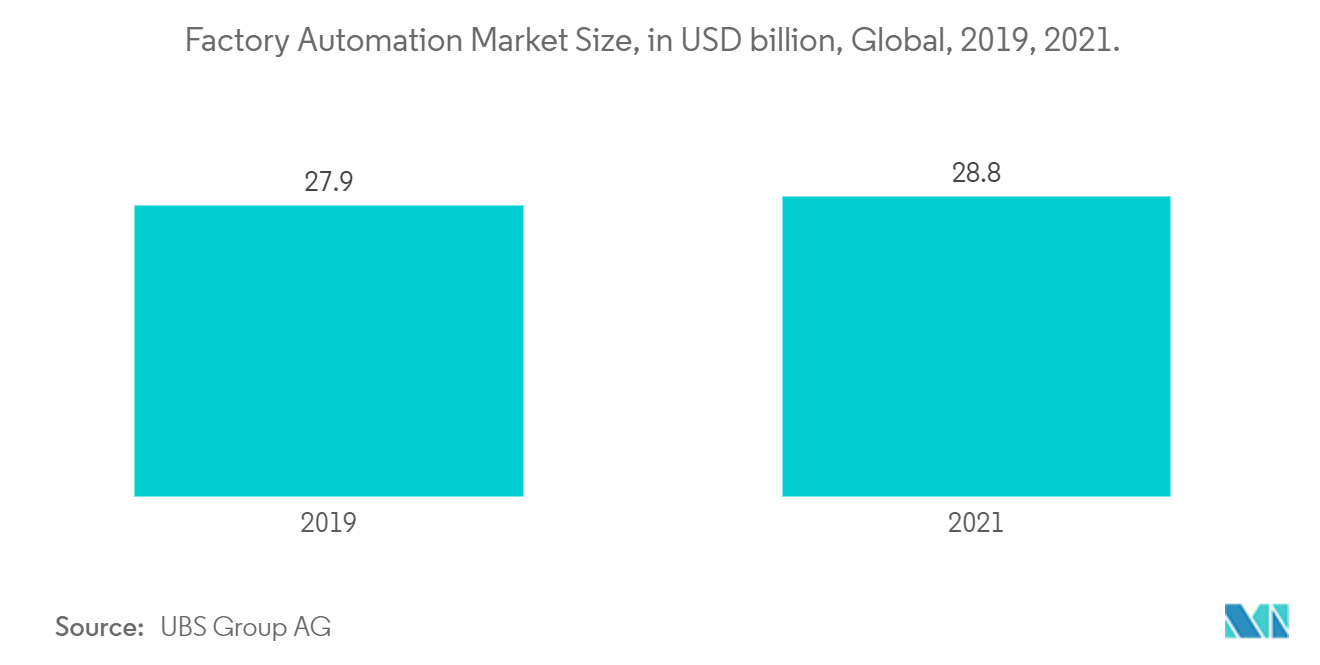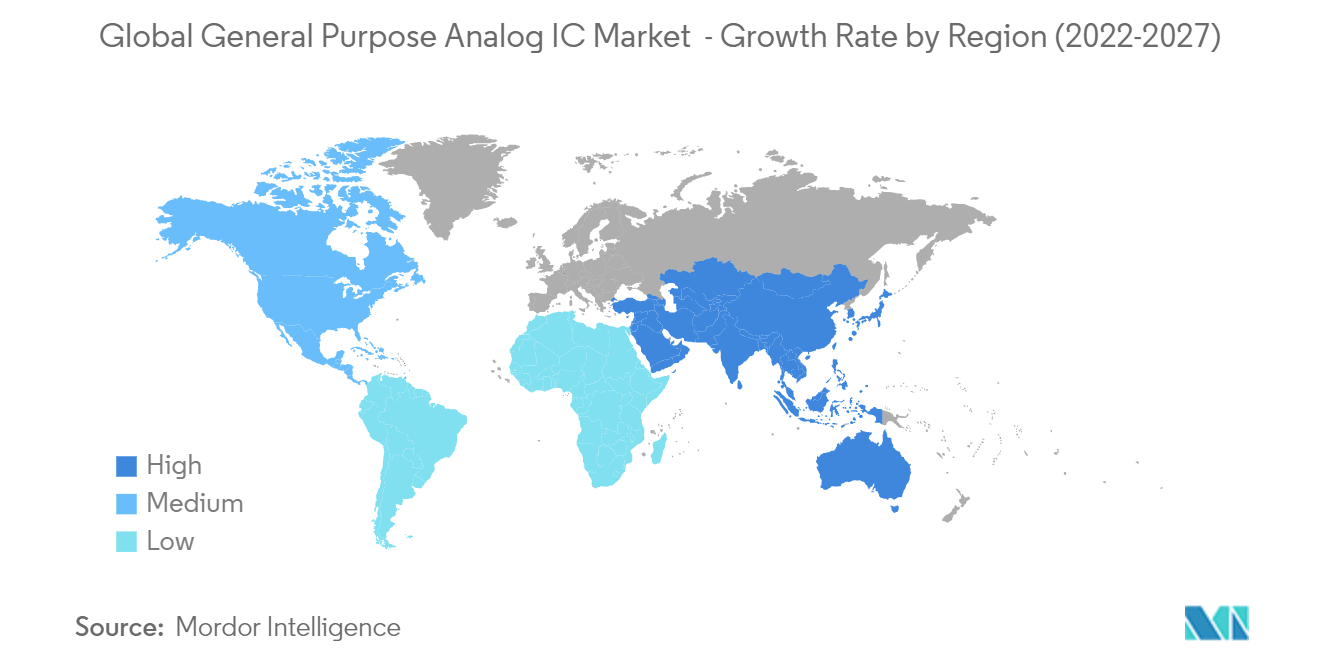Market Trends of Global General Purpose Analog IC Industry
This section covers the major market trends shaping the General Purpose Analog IC Market according to our research experts:
Increasing Factory Automation is Expected to Drive the Market's Growth
The automation industry has been revolutionized by combining digital and physical manufacturing aspects to deliver optimum performance. Further, the focus on achieving zero waste production and a shorter time to reach the market has augmented the market's growth.
The automotive industry is one of the prominent sectors that hold a significant in the worldwide automated manufacturing facilities. It is observed that the production facilities of various automakers are automated to maintain accuracy and efficiency. Further, the growing trend of replacing conventional vehicles with EVs is expected to augment the automotive industry's demand. One of the automotive industry's primary concerns is the project's duration. Quick return-on-investment projects, along with low-cost automation and cost innovation, may help the manufacturers improve competitiveness through efficiency improvement.
Fuelled by Industry 4.0, the United States continues to innovate and consolidate its position in the global market in the smart factory automation and industrial control systems industry. The embracing of smart technologies in the studied market has also positively imparted a direct impact on the national economy. The United States is a substantial market for vendors offering solutions for Smart Factories and is expected to grow significantly over the forecast period, owing to the early adoption of factory automation. Further, the developed infrastructure for automation in the country is also attracting players to invest in smart factory solutions.
For instance, in July 2021, Peak Performance Inc., in collaboration with the Tennessee Chamber/Tennessee Manufacturers Association and the Deutsche Messe Technology Academy, launched the first Smart Factory Institute in the United States. The Smart Factory Institute is a US-based organization that will provide manufacturers with connections, collaborative ties, and certifications to help them improve their manufacturing processes by giving them access to innovative manufacturing technology. Such developments would increase the penetration rate of factory automation, thereby facilitating the growth of the general purpose analog IC market.
Additionally, Australia and Singapore have witnessed a decline in the industrial sector over the past five years. For instance, According to the Australian Bureau of Statistics, the Gross value added (GVA) by the manufacturing industry in Australia decreased significantly by AUD 51 billion in 2021. Significant initiatives have resulted in increased attention being given to the digital economy and Industry 4.0 in the region, such as Singapore's Smart Nation and Committee for the Future Economy initiatives, Indonesia's "2020 Go Digital Vision", the "Thailand 4.0" initiative, the Vietnamese government's Industry 4.0 initiatives, amongst others, which is bringing increased scope for smart factory automation.
Further, the Chinese government's programs, such as the Made in China 2025 plan, promote the use of R&D in factory automation and technologies and its investments. Also, as most of the automation equipment is imported from Germany and Japan, the 'Made in China' initiative aims to expand the country's domestic production of automation hardware and equipment. Moreover, at the 2020 National People's Congress, the CCP announced that in addition to doubling down on its Made in China 2025 and China Standards 2035 initiatives, it announced to spend approximately USD 1.4 trillion on a digital infrastructure public spending program. China's New Infrastructure initiative presents exciting opportunities for global companies.
The increase in the need to reduce manufacturing costs and applications of the Internet of Things and machine-to-machine (M2M) technologies are fueling the market's growth in several regions.

The Asia Pacific Region is Expected to Witness a High Market Growth
The Asia Pacific region has a robust demand and manufacturing capabilities for consumer electronics. For instance, according to the National Bureau of Statistics of China, almost 1.5 billion cell phones will be produced in China in 2020. The nation produced 212.71 million units of cell phones in January/February 2022. China has been one of the leading global cell phone manufacturing countries and may continue to develop steadily soon. In addition to its established status as a manufacturing country for mobiles, China's domestic mobile phone market has become one of the largest cell phone markets in the world.
Further, according to the National Bureau of Statistics of China, the production of finished computers in China amounted to 63.87 million units in Jan/Feb 2021 and 61.85 million units in Jan/Feb 2022, respectively. In April 2022, around 32.66 million finished computers were produced in China. The massive electronics manufacturing capabilities of the region offer lucrative opportunities for the growth of the general purpose analog IC market.
Further, Japan has been at the forefront of the adoption of the latest technologies. For instance, the Japanese government announced Connected Industries in response to the German government's "Industry 4.0" program, and the momentum for a new manufacturing revolution is rising. The push toward smart factories is accelerating with technological advancements such as digitalization, production technology sophistication, and robotics to achieve higher efficiency in manufacturing.
The Smart Factory is a concept that attempts to optimize manufacturing operations and increase the efficiency and productivity of the entire factory, including digitalization and automation using robots and IoT to gather and analyze various data in the factory. For instance, as of April 1, 2021, JGC Japan Corporation launched its "Next Factory Solution Department.
Moreover, as electronics, automotive, and manufacturing sectors are evolving at a significant growth rate in economies like South Korea, Japan and India, there is a tremendous potential for growth in these regional markets. An upsurge in infrastructure investment by the government, coupled with the 'Make in India' initiative, is expected to drive the demand for various sensors used in them, thereby driving the demand for the studied market. The Government of India seeks to rise the manufacturing sector's share of the gross domestic product (GDP) to 25% by 2022, from 17% in 2018. Thus, manufacturers anticipate incorporating Industry 4.0 and other digital technologies to achieve this target. The adoption of automation technologies, IoT, and AI, aids the growth of the studied market.


